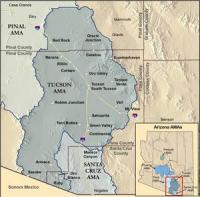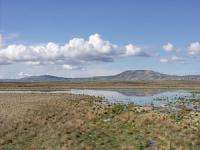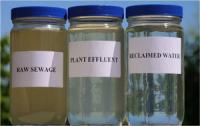-
Current water use for food production is unsustainable
About 40 percent of the water used for irrigation are unsustainable withdrawals that violate so-called environmental flows of rivers, a new study shows for the first time. If these volumes were to be re-allocated to the ecosystems, crop production would drop by at least 10 percent on half of all irrigated land, especially in Central and South Asia. Improvement of irrigation practices can sustainably compensate for such losses at global scale. More integrated strategies, including rainwater management could even achieve a 10 percent net gain of production.
-
-
Treated fracking wastewater may pollute Pennsylvania water sources for years
Given Pennsylvania’s abundant natural resources, it’s no surprise that the Commonwealth has become a mecca for hydraulic fracturing. Researchers, however, have recently discovered that releasing millions of gallons of treated hydraulic fracturing wastewater each year into area surface waters may have longer-lasting effects than originally thought.
-
-
Identifying global hotspots for water conflict
More than 1,400 new dams or water diversion projects are planned or already under construction and many of them are on rivers flowing through multiple nations, fueling the potential for increased water conflict between some countries. A new analysis uses a comprehensive combination of social, economic, political and environmental factors to identify areas around the world most at-risk for “hydro-political” strife.
-
-
Climate change to deplete some U.S. water basins, reduce irrigated crop yields
A new study by MIT climate scientists, economists, and agriculture experts finds that certain hotspots in the country will experience severe reductions in crop yields by 2050, due to climate change’s impact on irrigation. The most adversely affected region, according to the researchers, will be the Southwest. Already a water-stressed part of the country, this region is projected to experience reduced precipitation by midcentury. Less rainfall to the area will mean reduced runoff into water basins that feed irrigated fields.
-
-
Groundwater pumping drying up Great Plains streams
Farmers in the Great Plains of Nebraska, Colorado, Kansas, and the panhandle of Texas produce about one-sixth of the world’s grain, and water for these crops comes from the High Plains Aquifer — often known as the Ogallala Aquifer — the single greatest source of groundwater in North America. If pumping practices are not modified, scientists warn that these habitats will continue to shrink, and the fish populations along with them.
-
-
Safe water for slum dwellers
Attempts to deliver safe water to people living in some of the world’s poorest slums are falling at the final hurdle, according to experts. Sewage-contaminated drinking water causes serious illness such as diarrhea and other gastrointestinal and stomach problems – putting millions of lives at considerable risk each year. Globally, there are 1.7 billion cases of diarrhea annually resulting in over 0.5 million deaths of children under five years old. New research has shown that despite good progress, millions of slum dwellers are still exposed to considerable risk because water supplies are being contaminated by human waste just meters from the family home.
-
-
Water management interventions push water scarcity downstream
Human interventions to harness water resources, such as reservoirs, dams, and irrigation measures, have increased water availability for much of the global population, but at the same time, swept water scarcity problems downstream.
-
-
Helping repair California's water infrastructure
Recent extreme weather has put increased stress on California’s aging water infrastructure and highlighted the fact that the state must invest billions to improve and repair its civil infrastructure. The California Policy Center reports the infrastructure is currently designed to serve 20 million people in a state with a population of 40 million. The state relies on CSU water management, engineering, agriculture, and construction management experts to renovate aging dams, canals and aqueducts.
-
-
New water filtration technology uses 1,000 times less energy
With global demand for clean water increasing, there is a continuing need to improve the performance of water treatment processes. A new process for water filtration using carbon dioxide consumes one thousand times less energy than conventional methods, scientific research published this week has shown.
-
-
Europe’s economy vulnerable to global water scarcity, drought
A new study of the impacts that increasing water scarcity and drought may have on the European Union’s (EU) economy finds that around 38 percent of the EU’s water demand lies outside its borders because many of the goods consumed by its citizens or used by its businesses are produced abroad. “The highest risk that the European meat and dairy sector will face due to climate change and weather extremes lies outside its borders. This is because it is highly dependent on soybean imports from locations that are vulnerable to water scarcity and drought,” says one expert.
-
-
Home styles linked to high water use
Affluent neighborhoods with lawns — and occasionally swimming pools — use up to ten times more water than neighborhoods with higher density housing with less landscaping, according to a new study. The study points to the water-saving benefits of high-density neighborhoods such as more use of hardscaping, non-vegetative landscapes, as well as native plants in landscapes, which use less water than lawns.
-
-
Desert communities and the search for hidden water

In the 1800s, cowboys, ranchers, and miners quarreled over water in the American Southwest, over where to find it, and who could use it. Today, desert communities throughout the Southwest are still putting water availability at the top of their municipal agendas. one area stands out from the rest: the upper Santa Cruz Basin in Arizona has shown a remarkable capacity to store water. What causes the higher water availability in this area?
-
-
Western U.S.: Loss in water from melting snowpack due to human influence

Peak runoff in streams and rivers of the western United States is strongly influenced by melting of accumulated mountain snowpack. A significant decline in this resource has a direct connection to streamflow, with substantial economic and societal impacts. An international team of scientists has found that up to 20 percent loss in the annual maximum amount of water contained in the western United States’ mountain snowpack in the last three decades is due to human influence.
-
-
New filtration method makes water safe to drink

Researchers have created a membrane that removes viruses from treated wastewater and makes it safe for drinking. The new ultrafiltration method does not rely on chlorine, the commonly used chemical to purify water, which can cause contamination.
-
-
Identifying, utilizing water resources in Africa drylands
Researchers say that by 2050, almost half of the world’s population will live in countries with a chronic water shortage. In African drylands, it is not a water shortage problem, but an inability to capture water for food and other uses. Israeli scientists help villagers in Ethiopia, Zambia, and Uganda to identify water sources and test water quality – and also better capture and use water which is available.
-
- All
- Regional
- Water
- Biometrics
- Borders/Immig
- Business
- Cybersecurity
- Detection
- Disasters
- Government
- Infrastructure
- International
- Public health
- Public Safety
- Communication interoperabillity
- Emergency services
- Emergency medical services
- Fire
- First response
- IEDs
- Law Enforcement
- Law Enforcement Technology
- Military technology
- Nonlethal weapons
- Nuclear weapons
- Personal protection equipment
- Police
- Notification /alert systems
- Situational awareness
- Weapons systems
- Sci-Tech
- Sector Reports
- Surveillance
- Transportation
Advertising & Marketing: advertise@newswirepubs.com
Editorial: editor@newswirepubs.com
General: info@newswirepubs.com
2010-2011 © News Wire Publications, LLC News Wire Publications, LLC
220 Old Country Road | Suite 200 | Mineola | New York | 11501
Permissions and Policies
Editorial: editor@newswirepubs.com
General: info@newswirepubs.com
2010-2011 © News Wire Publications, LLC News Wire Publications, LLC
220 Old Country Road | Suite 200 | Mineola | New York | 11501
Permissions and Policies
